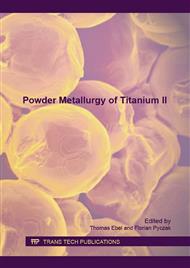[1]
M. Geetha, A.K. Singh, R. Asokamani, A.K. Gogia. Ti based biomaterials, the ultimate choice for orthopaedic implants - A review. Progress in Materials Science 54 (2009) 397-425.
DOI: 10.1016/j.pmatsci.2008.06.004
Google Scholar
[2]
M. Bryant, R. Farrar, R. Freeman, K. Brummitt, J. Nolan, A. Neville, Galvanically enhanced fretting-crevice corrosion of cemented femoral stems, J. Mech. Behav. Biomed. Mater. 40 (2014) 275-286.
DOI: 10.1016/j.jmbbm.2014.08.021
Google Scholar
[3]
M.P. Licausi, A. Igual Muñoz, V. Amigó Borrás, Influence of the fabrication process and fluoride content on the tribocorrosion behaviour of Ti6Al4V biomedical alloy in artificial saliva, J. Mech. Behav. Biomed. Mater. 20 (2013) 137-48.
DOI: 10.1016/j.jmbbm.2013.01.019
Google Scholar
[4]
C.E.B. Marino, L.H. Mascaro, EIS characterization of a Ti-dental implant in artificial saliva media: dissolution process of the oxide barrier, J. Electroanal. Chem. 568 (2004) 115-120.
DOI: 10.1016/j.jelechem.2004.01.011
Google Scholar
[5]
M.A. Arenas, A. Conde, J.J. Damborenea, The Role of Mechanically Activated Area on Tribocorrosion of CoCrMo, Metall. Mater. Trans. A. 44 (2013) 4382-4390.
DOI: 10.1007/s11661-013-1759-y
Google Scholar
[6]
M. Niinomi, Mechanical biocompatibilities of titanium alloys for biomedical applications. Journal of the mechanical behaviour of biomedical materials I (2008) 30-42.
DOI: 10.1016/j.jmbbm.2007.07.001
Google Scholar
[7]
Xuanyong Liu et al, Surface modification of titanium, titanium alloys, and related materials for biomedical applications. Materials Science and Engineering R 47 (2004) 49-121.
DOI: 10.1016/j.mser.2004.11.001
Google Scholar
[8]
R. G. Neves, B. Ferrari, A. J. Sanchez-Herencia, and E. Gordo, Colloidal approach for the design of Ti powders sinterable at low temperature, Mater. Lett., 107 (2013) 75-78.
DOI: 10.1016/j.matlet.2013.05.015
Google Scholar
[9]
R. G. Neves, B. Ferrari, A. J. Sanchez-Herencia, and E. Gordo, Design of Ti Microstructure by Addition of Ceramic Particles by Colloidal Techniques. PM Lightweight Materials, Proceedings of the EuroPM2014, Ed. EPMA.
Google Scholar
[10]
J. -S. Kim, K. -M. Lee, D. -H. Cho, Y. -Z. Lee, Fretting wear characteristics of titanium matrix composites reinforced by titanium boride and titanium carbide particulates, Wear. 301 (2013) 562- 568.
DOI: 10.1016/j.wear.2012.12.041
Google Scholar
[11]
Y. Qin, L. Geng, D. Ni, Dry sliding wear behavior of extruded titanium matrix composite reinforced by in situ TiB whisker and TiC particle, J. Mater. Sci. 46 (2011) 4980-4985.
DOI: 10.1007/s10853-011-5415-x
Google Scholar
[12]
I.Y. Kim, B.J. Choi, Y.J. Kim, Y.Z. Lee, Friction and wear behavior of titanium matrix (TiB+TiC) composites, Wear. 271 (2011) 1962-(1965).
DOI: 10.1016/j.wear.2010.12.072
Google Scholar
[13]
M.T. Mathew, P. Srinivasa Pai, R. Pourzal, A. Fischer, M.A. Wimmer, Significance of Tribocorrosion in Biomedical Applications: Overview and Current Status, Adv. Tribol. 2009 (2009) 1-12.
DOI: 10.1155/2009/250986
Google Scholar
[14]
S. Mischler, Triboelectrochemical techniques and interpretation methods in tribocorrosion: A comparative evaluation, Tribol. Int. 41 (2008) 573-583.
DOI: 10.1016/j.triboint.2007.11.003
Google Scholar
[15]
M.A. Arenas, A. Conde, J.J. Damborenea, The Role of Mechanically Activated Area on Tribocorrosion of CoCrMo, Metall. Mater. Trans. A. 44 (2013) 4382-4390.
DOI: 10.1007/s11661-013-1759-y
Google Scholar
[16]
J. Chen, F. Yan, Tribocorrosion behaviors of Ti-6Al-4V and Monel K500 alloys sliding against 316 stainless steel in artificial seawater, Trans. Nonferrous Met. Soc. China. 22 (2012) 1356-1365.
DOI: 10.1016/s1003-6326(11)61326-5
Google Scholar
[17]
Y. Liao, R. Pourzal, M.A. Wimmer, J.J. Jacobs, A. Fischer, L.D. Marks, Graphitic tribological layers in metal-on-metal hip replacements, Science. 334 (2011) 1687-90.
DOI: 10.1126/science.1213902
Google Scholar
[18]
R.G. Neves, B. ferrari, A.J. Sanchez-Herencia, C. Pagnoux, E. Gordo. Role of stabilizers in the design of Ti aqueous suspensions for pressure slip casting. Powder Technology, 263 (2014) 81-88.
DOI: 10.1016/j.powtec.2014.04.093
Google Scholar
[19]
Z. Doni, A.C. Alves, F. Toptan, J.R. Gomes, A. Ramalho, M. Buciumeanu, et al., Dry sliding and tribocorrosion behaviour of hot pressed CoCrMo biomedical alloy as compared with the cast CoCrMo and Ti6Al4V alloys, Mater. Des. 52 (2013) 47-57.
DOI: 10.1016/j.matdes.2013.05.032
Google Scholar
[20]
B.L. Lü, W.L. Zhou, G.Q. Chen, First-principles study on influence of alloying elements on electrochemical stability of cobalt-base alloys, Mater. Corros. 63 (2012) 735-738.
DOI: 10.1002/maco.201106074
Google Scholar
[21]
J. Chen, F.Y. Yan, B.B. Chen, J.Z. Wang, Assessing the tribocorrosion performance of Ti-6Al4V, 316 stainless steel and Monel K500 alloys in artificial seawater, Mater. Corros. 64 (2013) 394- 401.
DOI: 10.1002/maco.201106249
Google Scholar
[22]
T.C. Yap, N.S.M. El Tayeb, P.V. Brevern, K.S. Sim, Correlation of wear debris morphology and wear mechanism of Ti-5Al-4V-0. 6Mo-0. 4Fe slides against tungsten carbide under dry and cryogenic conditions, Int. J. Surf. Sci. Eng. 5 (2011) 463.
DOI: 10.1504/ijsurfse.2011.044401
Google Scholar
[23]
T.F.J. Quinn, Review of oxidational wear: Part I: The origins of oxidational wear, Tribol. Int. 16 (1983) 257-271.
DOI: 10.1016/0301-679x(83)90086-5
Google Scholar


